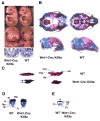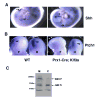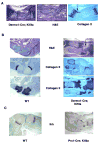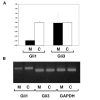Kinesin-2 controls development and patterning of the vertebrate skeleton by Hedgehog- and Gli3-dependent mechanisms
- PMID: 17698054
- PMCID: PMC2062520
- DOI: 10.1016/j.ydbio.2007.07.018
Kinesin-2 controls development and patterning of the vertebrate skeleton by Hedgehog- and Gli3-dependent mechanisms
Abstract
Hedgehog signaling plays an essential role in patterning of the vertebrate skeleton. Here we demonstrate that conditional inactivation of the Kif3a subunit of the kinesin-2 intraflagellar transport motor in mesenchymal skeletal progenitor cells results in severe patterning defects in the craniofacial area, the formation of split sternum and the development of polydactyly. These deformities are reminiscent of those previously described in mice with deregulated hedgehog signaling. We show that in Kif3a-deficient mesenchymal tissues both the repressor function of Gli3 transcription factor and the activation of the Shh transcriptional targets Ptch and Gli1 are compromised. Quantitative analysis of gene expression demonstrates that the Gli1 transcript level is dramatically reduced, whereas Gli3 expression is not significantly affected by kinesin-2 depletion. However, the motor appears to be required for the efficient cleavage of the full-length Gli3 transcription factor into a repressor form.
Figures







Similar articles
-
Limb anterior-posterior polarity integrates activator and repressor functions of GLI2 as well as GLI3.Dev Biol. 2012 Oct 1;370(1):110-24. doi: 10.1016/j.ydbio.2012.07.017. Epub 2012 Jul 25. Dev Biol. 2012. PMID: 22841643 Free PMC article.
-
Mouse limbs expressing only the Gli3 repressor resemble those of Sonic hedgehog mutants.Dev Biol. 2013 Jul 15;379(2):221-8. doi: 10.1016/j.ydbio.2013.04.025. Epub 2013 May 2. Dev Biol. 2013. PMID: 23644062 Free PMC article.
-
The output of Hedgehog signaling is controlled by the dynamic association between Suppressor of Fused and the Gli proteins.Genes Dev. 2010 Apr 1;24(7):670-82. doi: 10.1101/gad.1902910. Genes Dev. 2010. PMID: 20360384 Free PMC article.
-
Suppressor of fused controls mid-hindbrain patterning and cerebellar morphogenesis via GLI3 repressor.J Neurosci. 2011 Feb 2;31(5):1825-36. doi: 10.1523/JNEUROSCI.2166-10.2011. J Neurosci. 2011. PMID: 21289193 Free PMC article.
-
Gli proteins and the control of spinal-cord patterning.EMBO Rep. 2003 Aug;4(8):761-5. doi: 10.1038/sj.embor.embor896. EMBO Rep. 2003. PMID: 12897799 Free PMC article. Review.
Cited by
-
Kinesins and cancer.Nat Rev Cancer. 2012 Jul 24;12(8):527-39. doi: 10.1038/nrc3310. Nat Rev Cancer. 2012. PMID: 22825217 Review.
-
IFT80 is required for stem cell proliferation, differentiation, and odontoblast polarization during tooth development.Cell Death Dis. 2019 Jan 25;10(2):63. doi: 10.1038/s41419-018-0951-9. Cell Death Dis. 2019. PMID: 30683845 Free PMC article.
-
Molecular characterization of a KIF3A-like kinesin gene in the testis of the Chinese fire-bellied newt Cynops orientalis.Mol Biol Rep. 2012 Apr;39(4):4207-14. doi: 10.1007/s11033-011-1206-3. Epub 2011 Jul 20. Mol Biol Rep. 2012. PMID: 21773941
-
Disruption of kif3a results in defective osteoblastic differentiation in dental mesenchymal stem/precursor cells via the Wnt signaling pathway.Mol Med Rep. 2016 Sep;14(3):1891-900. doi: 10.3892/mmr.2016.5508. Epub 2016 Jul 12. Mol Med Rep. 2016. PMID: 27432616 Free PMC article.
-
Ciliopathic micrognathia is caused by aberrant skeletal differentiation and remodeling.Development. 2021 Feb 15;148(4):dev194175. doi: 10.1242/dev.194175. Development. 2021. PMID: 33589509 Free PMC article.
References
-
- Beales PL, Bland E, Tobin JL, Bacchelli C, Tuysuz B, Hill J, Rix S, Pearson CG, Kai M, Hartley J, Johnson C, Irving M, Elcioglu N, Winey M, Tada M, Scambler PJ. IFT80, which encodes a conserved intraflagellar transport protein, is mutated in Jeune asphyxiating thoracic dystrophy. Nat Genet. 2007 In Press. - PubMed
-
- Beech PL, Pagh-Roehl K, Noda Y, Hirokawa N, Burnside B, Rosenbaum JL. Localization of kinesin superfamily proteins to the connecting cilium of fish photoreceptors. J Cell Sci. 1996;109(Pt 4):889–897. - PubMed
-
- Brown CL, Maier KC, Stauber T, Ginkel LM, Wordeman L, Vernos I, Schroer TA. Kinesin-2 is a motor for late endosomes and lysosomes. Traffic. 2005;6:1114–1124. - PubMed
Publication types
MeSH terms
Substances
Grants and funding
LinkOut - more resources
Full Text Sources
Molecular Biology Databases

